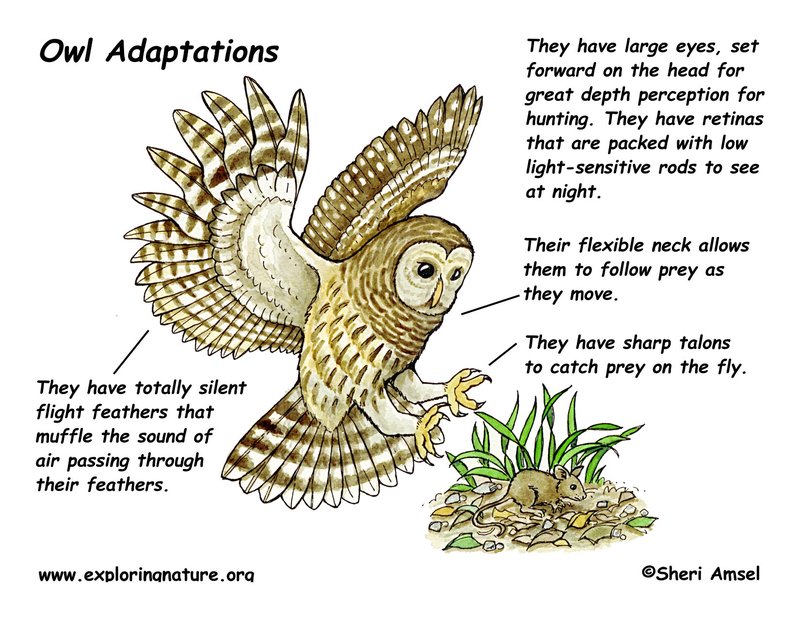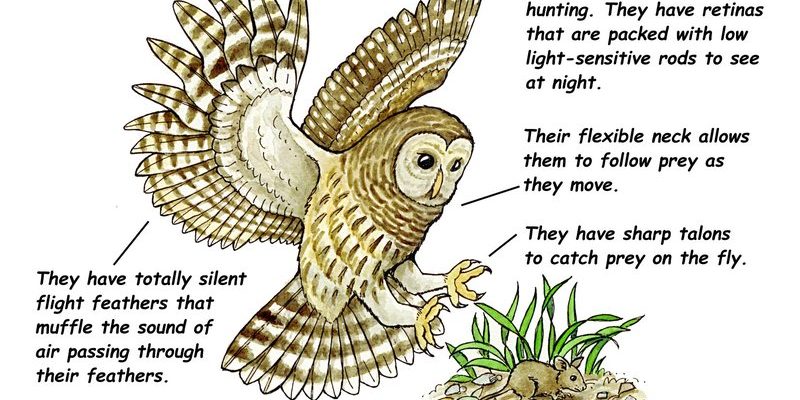
So, how do these feathered nocturnal hunters manage to survive and flourish where many other creatures struggle? Owls have developed a range of unique adaptations—think of them as specialized tools in their survival kit. From their amazing hearing to their camouflage and even their specific diet, owls are like nature’s ninjas. Let’s dive into the world of owls and explore how these amazing birds adapt to their environments.
The Art of Stealth: Camouflage and Physical Features
One of the most impressive adaptations of owls is their camouflage. Their feathers are typically mottled and patterned to blend in seamlessly with their surroundings. Think of how a chameleon changes color; owls do something similar, but instead of changing, they stay still and let their natural features do the work.
These feathers aren’t just for show. They serve a dual purpose—providing insulation during cold nights and aiding in silent flight. The edges of their wing feathers are serrated, which means they can swoop down on prey without making a sound. Talk about stealth mode! This ability to remain unnoticed is crucial for hunting and avoiding larger predators.
You might be wondering how successful this camouflage is. Well, many owls can sit perfectly still for extended periods, making them almost invisible in their natural habitat. This is especially crucial when they’re waiting to ambush unsuspecting small mammals or rodents. If you’ve ever spotted an owl while out in nature, you know just how easy it is to overlook them!
Superb Hearing: The Owl’s Secret Weapon
Have you ever heard of *asymmetrical* ears? It sounds like something out of a sci-fi movie, but it’s actually one of the cool adaptations that owls have. Unlike most birds, owls have ear openings that are placed at different heights on their heads. This unique feature allows them to pinpoint the source of sounds with incredible accuracy, even in complete darkness.
Imagine walking through a dimly-lit forest, and you hear a rustle in the bushes. With your ears, you might struggle to figure out where it came from. But an owl? They can locate not only the direction but also the distance of that sound. Their hearing is so acute that they can detect the faintest noises made by their prey, like a mouse scurrying through leaves or underbrush.
This precise hearing is essential for their survival. Owls mainly feed on small mammals, birds, and insects. The ability to locate these sounds amidst the background noise of the forest gives them a significant advantage. If you’ve ever doubted the idea of an owl being a skilled hunter, just remember: they often hunt in near-total darkness, relying on this superpower to seek out their meals.
Nocturnal Vision: Seeing in the Dark
Owls are known for their stunning night vision, but how do they really do it? Their large, forward-facing eyes give them a wide field of view and help them gather more light in low-light conditions. In fact, owl eyes have more rod cells—responsible for night vision—than cone cells, which detect color.
Think of it this way: if you were trying to see in the dark, having bigger eyes would help you capture more available light. That’s exactly what owls have done. Their eyes are so large that they can’t move them independently like humans can. Instead, they can rotate their heads up to 270 degrees—almost like a superhero move—allowing them to take in their surroundings without moving their bodies.
This level of vision is not just for show; it’s vital for hunting. Owls can spot movement from far away, allowing them to swoop in and catch their prey before it realizes what’s happening. Remember your last evening stroll when you caught just a glimpse of a shadow passing overhead? It was likely an owl using its impressive eyesight to hunt!
Diet and Hunting Strategies: Masters of the Night
Owls are incredibly versatile in their diets; they can eat a variety of prey, depending on their habitat and food availability. Most commonly, they enjoy small mammals like mice, voles, and even rabbits. Some species will also snack on insects, fish, or other birds. Their strong, hooked beaks and powerful talons make it easier for them to catch and tear apart their meals.
You may find it interesting that owls are opportunistic hunters. This means they won’t shy away from taking advantage of whatever is easiest to catch. If a particular food source is running low, they’ll switch things up and adapt their hunting strategies, ensuring they always have something to eat.
For younger owls, learning to hunt is a rite of passage. They’ll often practice their skills by pouncing on leaves or other stationary objects. Imagine learning to shoot hoops by tossing a ball at a laundry basket. It’s the same concept! With practice, they become proficient hunters, ready to tackle the challenges of the night.
Unique Nesting Habits: Finding Safe Havens
One aspect that often gets overlooked is how owls choose where to live and raise their young. Owls are known for their unique nesting habits, which can vary widely depending on the species. Some owls prefer to nest in tree cavities, while others might take over abandoned nests built by larger birds.
Think about it like this: if you were looking for a place to set up camp, you’d want somewhere safe and cozy. Owls do just that! They select locations that offer protection from predators and harsh weather. For example, the Great Horned Owl often uses old hawk nests or tree hollows, making them less vulnerable to danger.
Once the eggs are laid, the female takes on most of the incubation duties, while the male brings food. This teamwork ensures that the babies have the best chance of survival. It’s a beautiful example of how owls have adapted not just as individual creatures but as families working together to thrive in their environment.
Environmental Adaptations: Thriving in Diverse Ecosystems
Owls can be found in various ecosystems, from dense forests to arid deserts to urban areas. This adaptability is what has allowed them to spread and thrive in so many regions around the world. They can adjust their hunting methods, nesting practices, and even their diets depending on their surroundings.
For instance, in urban areas, owls often adapt to their environment by hunting smaller prey such as rats or pigeons. Instead of traditional hunting grounds, they might find a perch on a building to survey their territory. It’s a fascinating example of flexibility—much like how we adjust our lifestyles to fit our surroundings, owls do the same.
Moreover, some species have specialized adaptations. The Barn Owl, for example, has a heart-shaped face that helps funnel sound waves to their ears, making their hearing even more acute in open fields. These small but mighty changes make a big difference in how they hunt or interact with their environment.
Owls are remarkable birds with a fascinating array of adaptations that allow them to thrive in various environments. From their stealthy camouflage and acute hearing to their incredible night vision and unique nesting habits, they’ve developed the perfect toolkit for survival.
Honestly, it’s amazing to think about how these adaptations come together to create such resilient creatures. Whether they’re soaring silently through the night or perched high above in the trees, owls remind us of the wonders of nature and the importance of adaptability. The next time you hear an owl hoot or spot one in the wild, take a moment to appreciate the incredible journey they’ve taken to survive in an ever-changing world.

